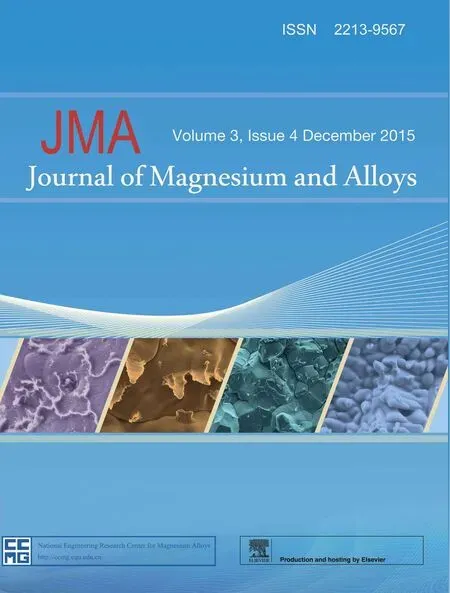Influenc of rolling directions on microstructure,mechanical properties and anisotropy of Mg-5Li-1Al-0.5Y alloy
2015-02-16TinlongZhuJinfengSunMilinZhng
,Tinlong Zhu,Jinfeng Sun,*,Milin Zhng
aKey Laboratory of Superlight Materials&Surface Technology,Ministry of Education,Harbin Engineering University,Harbin 150001,PR China
bShenyang Jinbo Gas Compressor Manufacturing Co.Ltd.,Shenyang 110027,PR China
cSchool of Materials Science and Engineering,Heilongjiang University of Science and Technology,Harbin 150022,PR China
Influenc of rolling directions on microstructure,mechanical properties and anisotropy of Mg-5Li-1Al-0.5Y alloy
Tianzi Wanga,Tianlong Zhub,Jianfeng Sunc,Ruizhi Wua,*,Milin Zhanga
aKey Laboratory of Superlight Materials&Surface Technology,Ministry of Education,Harbin Engineering University,Harbin 150001,PR China
bShenyang Jinbo Gas Compressor Manufacturing Co.Ltd.,Shenyang 110027,PR China
cSchool of Materials Science and Engineering,Heilongjiang University of Science and Technology,Harbin 150022,PR China
Mg-5Li-1Al-0.5Y alloy was rolled with different directions.The microstructure,mechanical properties and texture of the specimens were investigated with optical microscope,tensile tester and X-ray diffraction.The results show that changing rolling directions can refin the grain size of as-rolled alloys.Meanwhile,rolling directions have an obvious influenc on the mechanical properties and texture of Mg-5Li-1Al-0.5Y alloy, thus affecting the anisotropy of the alloy.The sheet,of which the RD(rolling direction)and ND(normal direction)are both changed between two passes,possesses the smallest anisotropy.From the texture results,changing rolling directions reduces the maximum pole density,making the highest point distribution region excursion and the highest point distributes more scatteredly.
Mg-Li alloy;Rolling directions;Microstructure;Mechanical property;Anisotropy
1.Introduction
As the lightest metallic engineering material with low density,high specifistiffness and strength,good magnetic shielding and shock resistance ability,Mg-Li alloy is a promising material in the field of aerospace,military,automotive and electronic industry[1,2].However,because of the relatively coarse grains and severe inhomogeneity microstructure,the as-cast Mg-Li alloy always possesses a poor strength,which limits its application.
The work performed by Herbstein and Averbach indicated that the addition of lithium decreases the crystal lattice axial ratio(c/a)of magnesium[3].Aluminum is the commonly used alloying element that can improve the mechanical properties of Mg-Li alloy[4].Trace rare-earth(RE)element can significanty weaken the basal texture of the Mg-Li alloy and increase its ductility[5,6].Yttrium is one of the typical RE element used in the Mg-Li alloy.
To improve the strength and ductility of the alloy,alloying and plastic processing are two effective ways.In previous work, the influenc of RE on microstructure and mechanical properties of Mg-Li based alloy has been studied in detail[7,8].The studies about plastic processing of Mg-Li alloy mainly concentrate on the influenc of single deformation or rolling deformation with single direction[9–11].However,there is rare literature about the influenc of rolling directions on microstructure,texture and mechanical properties of Mg-Li alloys.
In this paper,the microstructure,mechanical properties and anisotropy of the Mg-5Li-1Al-0.5Y alloy rolled with three different rolling directions were comparatively investigated.The texture evolution and plastic deformation mechanism of the alloy were also discussed.
2.Materials and methods
The Mg-5Li-1Al-0.5Y alloy used in the experiment was prepared from CP(commercial pure)magnesium(99.9%),CP lithium(99.9%),CP aluminum(99.9%)and the master alloy of Mg-17wt.%Y.The materials were melted in a medium frequencyinductionfurnaceundertheprotectionofargongas.The melt was cast into a book-shape steel mold,then the ingot was cut into specimens with dimensions of 120 mm× 100 mm×5 mm.Before rolling,the specimens were annealed
*Corresponding author.CollegeofMaterialsScience& Chemical Engineering,Harbin Engineering University,145 Nantong Street,Harbin, 150001,PR China.Tel.:+86 451 82569890;fax:+86 451 82569890.
E-mailaddresses:rzwu@hrbeu.edu.cn, ruizhiwu2006@yahoo.com (R.Wu).at 573K for 12h for homogenization and stress relieving.The rolling process was carried out at a temperature of 373K through two-pass rolling schedule with a total cumulative reduction of 34%.The rolling schedule is listed in Table 1.The rolling directions between rolling passes are shown in Fig.1. Deformation 1 means that RD(rolling direction),TD(transverse direction)and ND(normal direction)are all invariable.In this process,the sheet is named as sheet 1.As for deformation 2,RD deflect 180°C,while TD and ND are invariable.The corresponding sheet is named as sheet 2.As for deformation 3, TD is invariable,while RD and ND deflec 180°C.The corresponding sheet is named as sheet 3.At the interval between passes,the specimens were annealed at 373K for 0.5h.After rolling,the specimens were annealed at 523K for 0.5h.

Table 1Rolling schedule of the alloy.
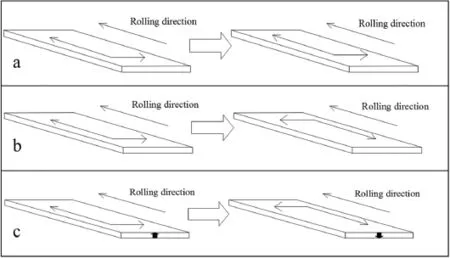
Fig.1.Diagrammatic drawing of different rolling processes:(a)deformation 1,(b)deformation 2 and(c)deformation 3.

Fig.2.Optical micrographs of Mg-5Li-1Al-0.5Y alloy:(a)as-cast alloy,(b)sheet 1,(c)sheet 2,and(d)sheet 3.

Fig.3.Optical micrograph of sheet 1(before annealing).
Specimens for microstructure observation were polished and etched with a solution of 6 vol.%nital mixed with a proper amount of picric acid.Then the microstructure was analyzed with LEICA DM IRM optical microscope.The strength and elongation were tested with MTS 50KN tensile tester at room temperature under an initial rate of 1×10−3s−1.The gauge dimensions of tensile specimen were 3 mm×3 mm×20 mm. The texture of the rolled specimens was measured using X‘pert PRO X-ray diffractometer,analyzing incomplete pole figure between 5°C and 70°C with back reflectio mode using Cu-Kα radiation at 40kv and 40 mA.The pole figure were recorded using the rotation of{0002},{101 0},{101 1}and{101 2}reflection then the inverse pole figure were calculated through the four reflections
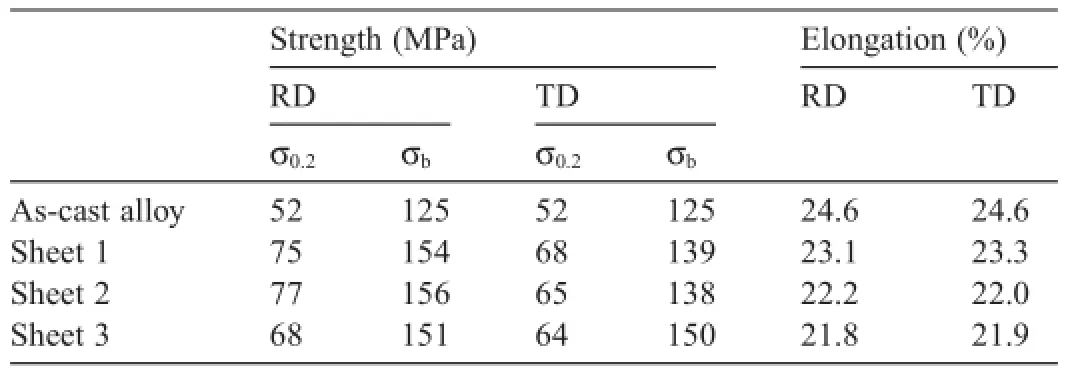
Table 2The strength and elongation of Mg-5Li-1Al-0.5Y alloy.
3.Results
3.1.Microstructure
Fig.2 shows the microstructure of as-cast and as-rolled Mg-5Li-1Al-0.5Y alloys.The grain size of the as-cast alloy is the largest among the four specimens,and some black secondary phases exist in the alloy.Zhu et al.[12]reported that the black secondary phase is Al2Y.Compared with Fig.2a,the grain size of the as-rolled specimens is much smaller(shown in Fig.2b,c and d);sheet 3 possesses the smallest and comparatively more uniform grain size.The Al2Y compounds still exist in the specimens,but most of them are crushed into fin particles.Few bulk Al2Y phase could also be found in sheet 1 and sheet 2.While in sheet 3,only some tiny particulate phase distributes in the grains.Fig.3 is the microstructure of sheet 1 before annealing.Many twins apparently distribute in grains. Compared with Fig.2,after annealing treatment,there exists almost no twins in the grains.
3.2.Mechanical properties
Table 2 lists the strength and elongation of the specimens. The data show that,after rolling,the tensile strength increases obviously,while the elongation slightly decreases.Fig.4 shows the tensile strength and yield strength variations of as-rolled Mg-5Li-1Al-0.5Y with three different rolling directions.Along RD,sheet 1 and sheet 2 possess the similar values of σband σ0.2, somewhat higher than that of sheet 3.Along TD,the three sheets possess the similar σ0.2values,while sheet 3 possesses a higher σbthan the others.Fig.5 shows the elongation variation of the as-rolled alloys along RD and TD,respectively.With the changing of rolling directions,the elongation of the sheet slightly decreases.The three sheets all show an inconspicuous plastic anisotropy along TD and RD.
Combined with Table 2,Fig.4 and Fig.5,it can be concluded that the strength along RD is higher than that along TD. The tensile strength along RD of the three as-rolled sheets shows little difference.Along TD,the tensile strength value of the three specimens are lower than that along RD.The tensilestrength of sheet 3 is higher than that of sheet 1 and sheet 2, almost the same as that along RD.The elongation value of the three sheets all keeps a high level,and changing rolling directions shows no significan impact on it.Sheet 3 possesses almost no anisotropy.
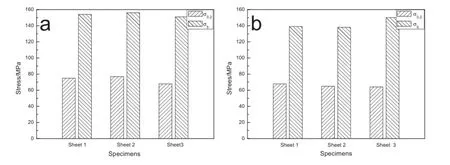
Fig.4.Tensile strength and yield strength of as-rolled Mg-5Li-1Al-0.5Y alloys:(a)RD and(b)TD.
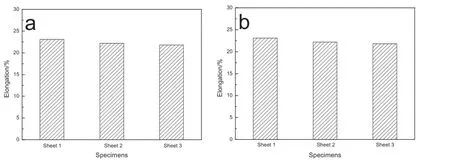
Fig.5.Elongation of as-rolled Mg-5Li-1Al-0.5Y alloys:(a)RD and(b)TD.
3.3.Texture
Figs.6–9 illustrate the texture of the three as-rolled specimens.Fig.6 is the pole figure of sheet 1.In the pole figur of (0002),the grain orientation is located approximately 35°C from the c-axis towards TD.There also exists highest intensity points distributing about 55°C from the c-axis toward RD in the (101 1)pole figure and approximately 45°C from the c-axis toward downside of RD in the(101 2)figure The pole density distribution is scattered in the pole figur of(101 0).Compared with the pole figure of other magnesium alloys with basal texture,it can be inferred that a non-basal texture exists in the alloy during rolling.

Fig.6.Pole figure of sheet 1.

Fig.7.Pole figure of sheet 2.
As for sheet 2,the maximum texture intensity distributes about 45°C from the c-axis toward RD in the(0002)pole figure the pole figure ofanddo not exist in a large pole density region(as shown in Fig.7).Fig.8 is the pole figure of sheet 3.The basal peak distributes about 55°C from the c-axis toward the intermediate between RD and TD.As the same with sheet 2,there exists no large pole density region in the pole figure ofandHowever,as for sheet 2 and sheet 3,the texture intensity varies in a narrow range,which means weak grain-oriented.
Fig.9 reveals the inverse pole figure of the as-rolled Mg-5Li-1Al-0.5Y alloys.In these images,RD is the macroscopic coordinate direction.In Fig.9a,the crystal orientation concentrates on thedirection,namely//RD.In Fig.9b,the crystal orientation gradually excursion to the 112 0direction,and it distributes more scatteredly than sheet 1.In Fig.9c,the maximum intensity of the texture distributes more scatteredly betweenand.It indicates that changing rolling direction weakens the texture of as-rolled alloy,increasing the random of the texture.Meanwhile,with the changing of rolling direction,the maximum of pole density decreases from 1.545 to 1.303,thus keeping the elongation of the alloy remains at a high level.
From the results mentioned above,it can be concluded that the as-rolled specimens do not possess a typical basal texture, showing that the non-basal slip is activated during rolling at 373K.Comparing Figs.6–8,with the changing of rolling directions,the highest intensity region distribution gradually moves outwards from the c-axis and the scope of the texture intensity becomes narrow.Fig.9 illustrates that,after changing the rolling directions,the pole density decreases.Meanwhile,the texture region gradually deflect fromto,until it evenly distributes.The changing of rolling directions weakens the anisotropy of the alloy,and sheet 3 possesses outstanding comprehensive mechanical properties.
4.Discussion
Due to the low stacking fault energy of Mg-Li alloy,rolling deformation of the alloy is given priority to DRX(dynamic recrystallization).Ma et al.[13]shows that new grains generated by DRX with a low dislocation density also participate in the texture evolution as the strain increases.
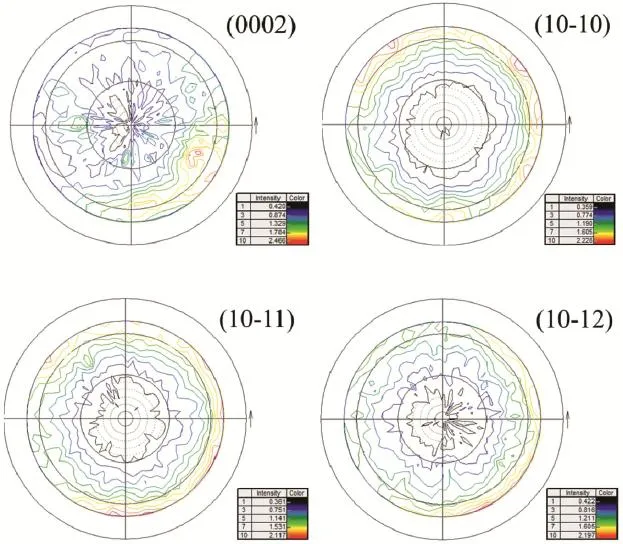
Fig.8.Pole figure of sheet 3.
In this study,the rolling temperature is 373K,which is lower than the recrystallization temperature.However,alloys containing rare earth elements and/or yttrium(RE/Y)can develop more random textures[14].The addition of Y causes the formation of Al2Y phase.The particles of Al2Y compound in magnesium alloys can promote DRX during the process of rolling and provide more approaches for nucleation of DRX texture,weakening the basal texture.PSN(particle stimulated nucleation)is the reason of weakening the basal texture.In addition,the rare earth elements atoms that solute in magnesium alloy will not only change the bond energy of RE-Mg and Mg-Mg around rare earth atoms,but also change the stacking fault energy of basal and non-basal planes,thus changing CRSS (critical shear stress)of the basal and non-basal slip systems,narrowing extended dislocation and causing it being easily trapped into perfect dislocation[15].Therefore,the non-basal slip system can be activated easily.

Fig.9.Inverse pole figure of the as-rolled alloys:(a)sheet 1,(b)sheet 2 and(c)sheet 3.
After two-pass rolling,some twins are found in the grains. The stress relief annealing makes many of them disappear, instead of isometric crystal grains,causing the grain refine ment.Three types of rolling deformation processes make different influence on the alloy.As for the sheet 1,the upside surface suffers a relatively larger deformation than the downside surface;meanwhile,the stress inhomogeneously distributes on the same surface,and DRX easily occurs in the coarse grains.After changing the rolling directions,such as sheet 2, the same surface possesses similar deflection increasing the uniformity of grain size.Sheet 3 not only possesses similar deflectio in the same surface,but also makes the upside and downside surfaces be deformed uniformly.The grains are refine and become more uniform with the changing of rolling direction,which weakens the anisotropy of the alloy.Sheet 3 possesses the smallest grain size and the most uniform grains, thus possessing the outstanding comprehensive mechanical performance.
As a supplement coordinate deformation mechanism,the twining during rolling process can not only provide some independent slip systems,but also cut the coarse grains and cause grain refinemen[13].Changing rolling directions can affect the distribution of accumulated deformation twinning,especially the compression twinning and double twinning.During the low temperature rolling and heat treatment,the recrystallization occurs.With the procedure of transformation from twin boundaries into recrystallization grain boundaries,the texture evolves with a small deflection thereby affecting the strength and elongation of the alloy.The anisotropy of the alloy also changes.
Kaiser et al.[16]proposed that the distribution of the(0002) basal plane has a significan influenc on the planar anisotropy of the sheet.As mentioned by Chen et al.[17],the texture exhibits greater spreading of the basal poles toward the RD than the TD,whereby activation of the basal slip in the sheet rolling direction is preferred to the TD.This would result in lower stresses necessary for the 90°C orientation,hence decreasing the yield strength.Lee et al.[18]calculated the Lankford parameter of the rolled RD,TD and ND directions.The results revealed that the r-values of the RD plane are much greater than those of theTD and ND planes.Therefore,the strength in RD is larger than that in TD.With the changing of rolling directions, the basal pole in(0002)basal plane starts deflecting no longer toward RD.As for sheet 3,the basal peak distributes from the c-axis toward the intermediate between RD and TD.Meanwhile,the maximum of the pole density decreases in the inverse pole figures thus weakening the anisotropy of the alloy.
5.Conclusions
The rolling directions affect the microstructure and texture of Mg-5Li-1Al-0.5Y alloy,thus making influence on the mechanical properties of the alloy.
1 The changing of rolling directions can refin the grains.
2 The changing of rolling directions keeps the strength and elongation remaining at a high level both along RD and TD. Rolling directions affect the anisotropy of the alloy.The sheet,of which the RD and ND are both changed between two passes,has the smallest anisotropy.
3 The changing of rolling directions affects the texture of Mg-5Li-1Al-0.5Y alloy.It reduces the maximum pole density,making the highest point distribution region excursion and the highest point distributes more scatteredly.
4 The addition of yttrium promotes DRX through PSN mechanism,weakening the basal texture and reducing the anisotropy of the alloy.
Acknowledgements
This work was supported by the Heilongjiang Province Youth Skeleton Program(1252G018),Research Fund for the Doctoral Program of Higher Education(20132304110006), Project of Science and Technology of Heilongjiang Province Education Department(12511068),Fundamental Research Funds forthe CentralUniversities(HEUCF20151006), Heilongjiang Province Natural Science Foundation(E201420) and Harbin City Application Technology Research and Devolopment Project(2015AE005).
[1]D.K.Xu,E.H.Han,Scr.Mater.71(2014)21–24.
[2]R.Z.Wu,Y.D.Yan,G.X.Wang,L.E.Murr,W.Han,Z.W.Zhang,et al., Inter.Mater.Rev.60(2015)65–100.
[3]F.H.Herbstein,B.L.Averbach,Acta Metall.4(1956)407–413.
[4]R.Z.Wu,Z.K.Qu,M.L.Zhang,Rev.Adv.Mater.Sci.24(2010)35–43.
[5]M.Li,H.Hao,A.M.Zhang,Y.D.Song,X.G.Zhang,J.Rare Earths 30 (2012)492–496.
[6]N.Stanford,D.Atwell,A.Beer,C.Davies,M.R.Barnett,Scr.Mater.59 (2008)772–775.
[7]X.Y.Guo,R.Z.Wu,J.H.Zhang,B.Liu,M.L.Zhang,Mater.Des.53 (2014)528–533.
[8]L.Bao,Q.C.Le,Z.Q.Zhang,J.Z.Cui,Q.X.Li,J.Magnes.Alloys 1(2013) 139–144.
[9]H.W.Dong,F.S.Pan,B.Jiang,Y.Zeng,Mater.Des.57(2014)121–127.
[10]D.Zdeneˇk,T.Zuzanka,K.Stanislav,J.Alloys Compd.378(2004) 192–195.
[11]M.Karami,R.Mahmudi,J.Mater.Sci.44(2013)3934–3946.
[12]T.L.Zhu,J.F.Sun,C.L.Cui,R.Z.Wu,B.Sergey,Z.Leng,et al.,Mater. Sci.Eng.A 600(2014)1–7.
[13]Q.Ma,B.Li,W.R.Whittington,A.L.Oppedal,P.T.Wang,M.F. Horstemeyer,Acta Mater.67(2014)102–115.
[14]J.Bohlen,M.R.Nürnberg,J.W.Senn,D.Letzig,S.R.Agnew,Acta Metall. 55(2007)2101–2112.
[15]C.L.Cui,L.B.Wu,R.Z.Wu,J.H.Zhang,M.L.Zhang,J.Alloys Compd. 509(2011)9045–9049.
[16]F.Kaiser,D.Letzig,J.Bohlen,A.Styczynski,C.H.Hartig,K.U.Kainer, Mater.Sci.Forum 419-422(2003)315–320.
[17]X.P.Chen,D.Shang,R.Xiao,G.J.Huang,Q.Liu,Trans.Nonferrous Met. Soc.China 20(2010)s589–s593.
[18]B.H.Lee,S.H.Park,S.G.Hong,K.T.Park,C.S.Lee,Mater.Sci.Eng.A 528(2011)1162–1172.
Received 10 October 2015;accepted 9 November 2015 Available online 2 December 2015
http://dx.doi.org/10.1016/j.jma.2015.11.001
2213-9567/©2015 Production and hosting by Elsevier B.V.on behalf of Chongqing University.
©2015 Production and hosting by Elsevier B.V.on behalf of Chongqing University.
杂志排行
Journal of Magnesium and Alloys的其它文章
- GUIDE FOR AUTHORS
- Influenc of tool material and rotational speed on mechanical properties of friction stir welded AZ31B magnesium alloy
- Joining of AZ31 and AZ91 Mg alloys by friction stir welding
- Grain growth in calibre rolled Mg–3Al–1Zn alloy and its effect on hardness
- Characteristics of friction welded AZ31B magnesium–commercial pure titanium dissimilar joints
- Anisotropy of the crystallographic orientation and corrosion performance of high-strength AZ80 Mg alloy
